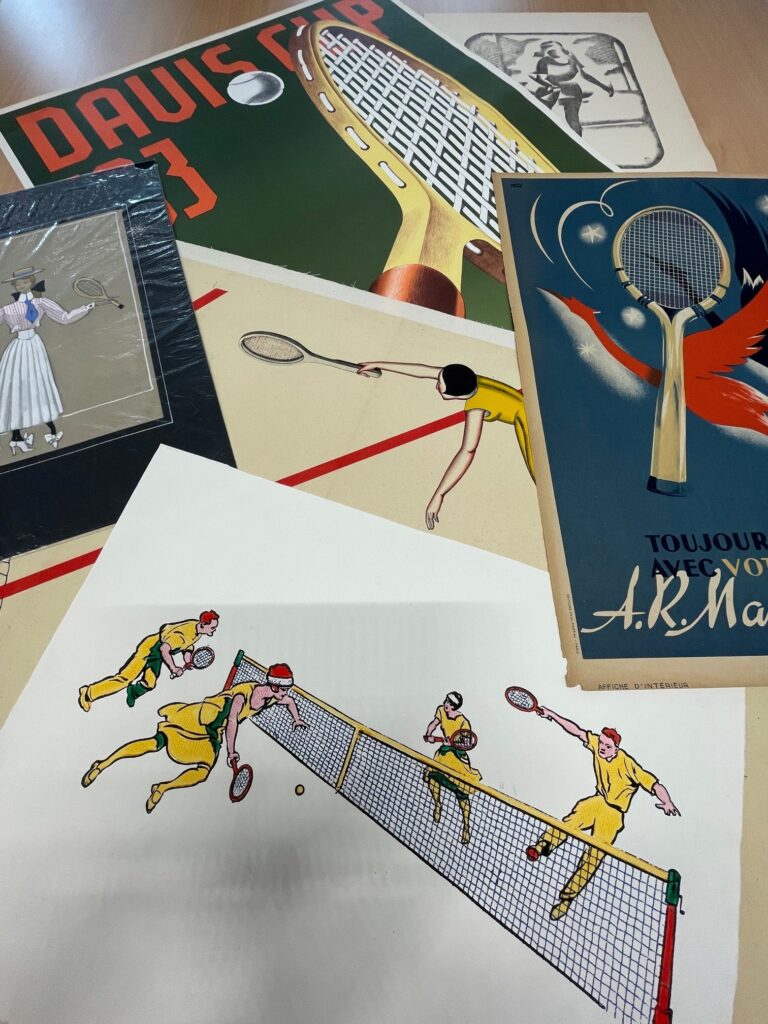Dad kept everything; he was a born collector. In his study, we found texts corrected by hand by Giorgio Bassani and Mario Soldati, interview notebooks, books he read to write his own, some opening lines of novels that never saw the light of day, and, of course, different versions of his texts. I believe that a sort of “Clerici method” could be derived from this, which would be valuable for young people, including, perhaps, his aspiring colleagues of tomorrow.
Carlotta Clerici

Tennis memorabilia
If today we can actually talk about a ‘Gianni Clerici Fund’, we owe it to Gianni’s meticulous commitment to collecting, tirelessly gathering books, magazines, posters, and memorabilia of all kinds related to the world of tennis. With regard to the library in particular, his meticulous approach and philological approach allowed him to carefully filter the material, so as to build an organic and extremely complete collection: it is no coincidence that, among tennis history libraries, Gianni Clerici’s is perhaps second only to that of the Wimbledon Lawn Tennis Museum in terms of uniqueness and completeness. In addition to monographs (more than a thousand), the collection consists of: numerous volumes of specialist magazines (Italian, French, English, and American); the document archive, with notes, drafts (including typescripts of some of his novels with handwritten corrections by Sergio Ferrero, Mario Soldati, and Giorgio Bassani) and unpublished texts; correspondence; the complete collection of his articles divided by year; over three hundred posters, playbills, and preparatory prints for his publications; more than 1,700 photographs.
An enchanting apparition
The donation of the Clerici Fund to the Catholic University dates back to March 2023, when the writer’s family decided to entrust the material to the Brescia university, thanks to the fundamental mediation of Francesco Rognoni, professor of English Literature. When he went to the Clerici home in Bellagio (CO) to view Gianni’s correspondence with the writer Sergio Ferrero, on whom he was conducting some research, he was amazed at the sight of the impressive library, three veritable ‘walls of books’: Rognoni therefore committed himself to ensuring that the scribe’s treasure became part of the ‘Historical Collections’ of the Catholic University of Brescia. The details of the acquisition are described by the person concerned, interviewed in June 2023:
Why at the Catholic University?
Speaking of unique and valuable collections, the Clerici Fund is matched by another exceptional collection at the Brescia site, the Viganò Library, which houses around ten thousand scientific volumes, including incunabula, manuscripts, 16th-century editions, and more recent books. If you look closely at the shelves, you can find a hidden gem: Messer Antonio Scaino da Salò’s Trattato del giuoco della palla (Treatise on the Game of Ball) from 1555, generally considered the first treatise on tennis in history. It was also from this work that Clerici drew inspiration to compile his masterpiece, 500 Years of Tennis, which for many represents the encyclopaedia of tennis par excellence, a text known and appreciated abroad, as evidenced by its translations into several languages.
A literary streak
It is no coincidence that Gianni Clerici called himself ‘the scribe of tennis’. From the very beginning, his writing resonated with the notes of the great prose writers and poets. His newspaper articles transcend the boundaries of news reporting and belong to a hybrid genre that could be defined as literary journalism. Moreover, his career soon branched out: in 1966, his debut novel Fuori rosa (Vallecchi Editore, Florence) was published and presented by his friends Giorgio Bassani and Mario Soldati at the Strega Prize that same year. This first experiment was followed by dozens of novels, short stories, plays, and poetry collections, in a career studded with satisfactions and laurels on the journalistic front and slowed down by a few misunderstandings on the literary front. In addition to a wide variety of books on tennis, the collection also contains Gianni’s correspondence with prominent figures in the world of literature, including Oreste del Buono and Alberto Arbasino, as well as the aforementioned Ferrero, Bassani, and Soldati.

